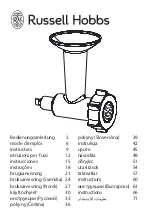
11
0800 422 274
NZ
IMPORTANT: READ BEFORE FIRST USE!
Food Preparation Tips
• Pre-freeze
liquids or food with a high water content
(e.g. sauces, beverages,
soups, stock) in a casserole dish, loaf pan or ice cube tray before vacuum
sealing. Then stack the bags in the freezer. This way no liquid can get sucked
into the vacuum pump and the food will not get squashed.
• Should any
liquid
get sucked in, IMMEDIATELY press the Cancel button and
unplug the appliance
to avoid risk of electric shock and damage to the appli-
ance. Clean and dry the appliance thoroughly.
• When vacuum sealing
powdery or finely ground food
like flour, it is best to
use the food's original packaging inside the vacuum bags, or place a paper
filter bag on top of the food. Otherwise the fine powder could get sucked into
the machine and cause enough damage to shorten the life of the Vacuum
Food Sealer.
• Before vacuum sealing
fish
, remove its innards.
• We recommend pre-freezing
meat and fish
for 1–2 hours before vacuum
sealing. This helps retain the juice and shape, and provides for a better seal.
If you cannot pre-freeze it, place a folded paper towel between the food and
top of the bag, but below the seal area. Leave the paper towel in the bag to
absorb excess moisture and juices during the vacuum sealing process.
• When vacuum sealing
food with sharp edges and points
like fish bones and
hard shells, carefully wrap this type of food with kitchen paper before vacuum
sealing. Sharp edges and points may penetrate and tear the bag.
• Vegetables
should be blanched to stop the enzyme action that could lead to
loss of flavour, colour and texture during storage. To blanch vegetables, place
them in simmering water, or in a microwave, until they are cooked but still
crisp. (Blanching times can range from 1–2 minutes for leafy greens and peas,
3–4 minutes for snap peas, sliced zucchini or broccoli, about 5 minutes for
carrots, and 7–11 minutes for corn on the cob.) After blanching, immerse the
vegetables in cold water to stop the cooking process.
• Pre-freeze the
vegetables
for 1–2 hours, then vacuum seal them in the
portion size you require and return to the freezer for storage.
• When vacuum sealing
cheese
, make the bag just a little longer than needed,
then you can re-seal the bag after each use.
• IMPORTANT:
DO NOT vacuum seal soft cheese, fresh mushrooms,
onions and garlic
due to the risk of anaerobic bacteria.
Other foods
not
suitable for vacuum sealing
include carbonated beverages (such as
lemonade), biscuits made from beaten egg whites and meringues.
Getting Started (Cont.)

































